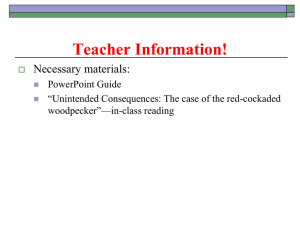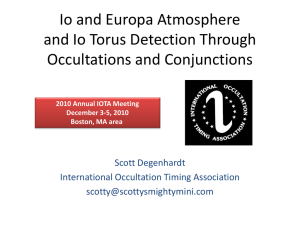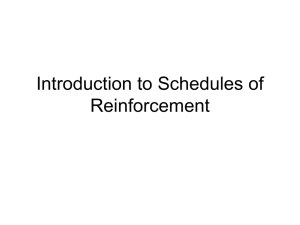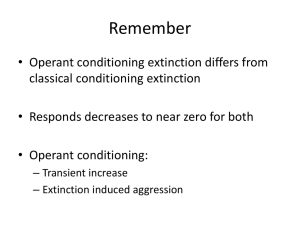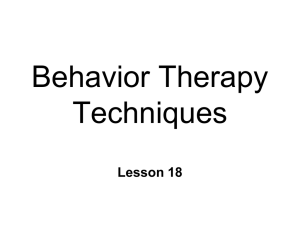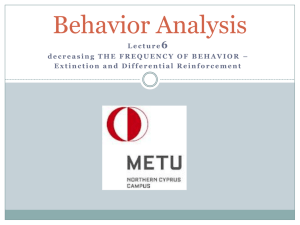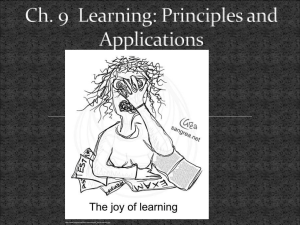Chapter 9: Extinction of Conditioned Behavior
advertisement
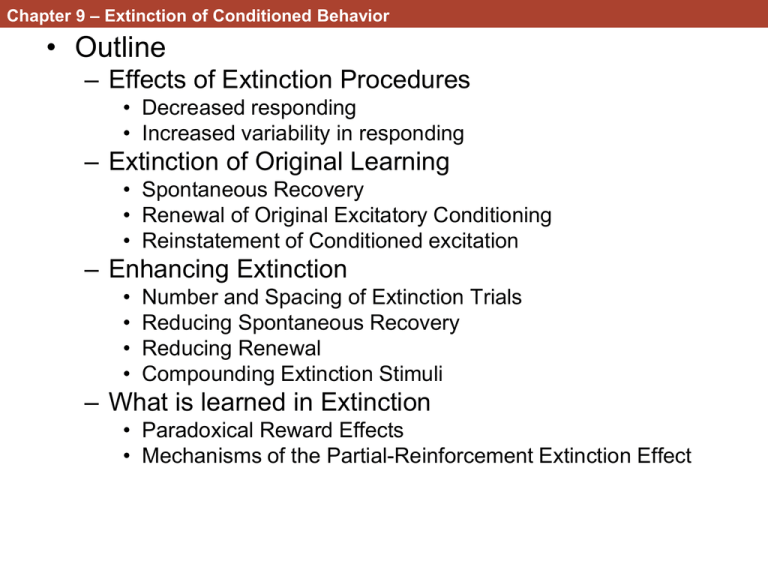
Chapter 9 – Extinction of Conditioned Behavior • Outline – Effects of Extinction Procedures • Decreased responding • Increased variability in responding – Extinction of Original Learning • Spontaneous Recovery • Renewal of Original Excitatory Conditioning • Reinstatement of Conditioned excitation – Enhancing Extinction • • • • Number and Spacing of Extinction Trials Reducing Spontaneous Recovery Reducing Renewal Compounding Extinction Stimuli – What is learned in Extinction • Paradoxical Reward Effects • Mechanisms of the Partial-Reinforcement Extinction Effect • So far we have focused on acquisition effects. – What happens when a stimulus predicts the presence of some outcome • This chapter focuses on what happens when that outcome is later omitted • Pavlovian – Acquisition • CS-US – Extinction • CS alone • Instrumental – Acquisition • S+ – Barpress/keypeck RF – Extinction • Barpress/keypeck no longer RF • Extinction is a hot area of research – Particularly relevant to therapy • Exposure therapies for phobias – Extinguish fear • Also for drug addictions – Extinguish cues for drug taking behavior • Effects of Extinction Procedures – Domjan’s key example • Key no longer works for door – What do you do? » Try several times » Try it in a variety of ways » Jiggle it » Eventually quit • Effects of Extinction – Decrease in responding – Increase in variability of responding • Empirical Evidence – Neuringer, Kornell, and Olufs (2001) – Right lever(R), left lever (L), key (K) • Three responses required • Group Var – Not allowed to repeat • Yoked control – No variability requirement but RF was yoked to Group Var Train Extinction Var Variability control control Var Responding • Extinction also can cause a strong emotional response – Frustration (possible aggression) • Car won’t start • Vending machine doesn’t work • Pigeon’s out of food • Pigeon’s key pecking with restrained partner – Extinction = attack • Extinction and Original Learning – Does extinction erase original learning • Evidence says no – From several lines » Spontaneous Recovery » Renewal » Reinstatement » Retention of knowledge of the Reinforcer • Spontaneous Recovery – Phase 1 • acquisition – Train CS-US – Phase 2 • extinction – CS alone – Phase 3 • Time off – Phase 4 • Extinction • What does Spontaneous recovery tell us about extinction learning? – Original learning remains • A little time off? – Responding returns • Renewal – A shift in context can renew extinguished learning • bring back responding – Demonstrated by Bouton and King (1983) • used the conditioned suppression procedure. • Phase 1 – Train all rats to bar press • Phase 2 – Train conditioned emotional response to a CS (tone) • CS (tone) US (shock) • Phase 3 (Extinction) – 3 Groups • Group Ext A) – Extinguish CER same context as phase 1 and 2 » Present CS alone in same context • Group Ext B) – Extinguish CER different context » Present CS alone in different context • Group NE – No extinction • Test – Conditioned suppression to tone in original context • Result – Ext A? • No Fear – Ext B? • Fear – NE? • Most Fear • Which group demonstrated Renewal? • What does this say about Extinction? – 1) Initial learning is not forgotten – 2) Extinction is at least somewhat context specific • Has implications for therapists attempting to extinguish unwanted behaviors – Extinction of phobia or drug taking behavior may be specific to the therapists office – Extinction in multiple contexts? • Reinstatement – Exposure to the US serves as a reminder • reinstates an extinguished response. • Train – CS (tone) US (shock) – tone elicits fear. • Extinction – CS alone. • Reinstatement – US alone • Test – Fear tone? • Yes = reinstatement • Like Renewal, Reinstatement is context specific – US exposure works best if in the same context • Reinstatement is also an issue for therapists – Worry that extinguished fears/behaviors will return if exposed to certain reminder stimuli • Patient has intimacy issues because of abusive parents – Treated with therapy • Abusive encounter later in life – Reinstates intimacy issues? • Enhancing Extinction – Because Extinction can be so useful therapeutically,efforts have been made to enhance it • Number and Spacing of Extinction of Trials – More extinction is more effective • Makes sense – New learning after all – Massed trials are more effective than spaced trials • This effect seems to be temporary – Within session effect » Large spontaneous recovery • Reducing Spontaneous Recovery – Repeated spontaneous recovery sessions reduces the effect – If there are cues that are specific to extinction, those cues can be effective in reducing spontaneous recovery • Requires special extinction cues • Reducing Renewal – Providing extinction training in multiple contexts can reduce renewal effects – Extinction cues can reduce renewal • Same as for spontaneous recovery • patients asked to recall the context of extinction training (therapists office) showed reduced anxiety in novel locations • Prompted some therapists to specifically train “portable” extinction cues – Memorize a specific “relaxation phrase” or carry a “relaxation card” • One view of extinction is that it is due to an increase in frustration that interferes with normal responding • Paradoxical Reward Effects – support the acquired frustration view of extinction • Whenever expectancy of reward is greatest following training, extinction occurs fastest • The Paradox? – Better acquisition causes faster extinction • we might expect that the better learning would slow extinction – Not the case • Overtraining extinction effect – More training = faster extinction • animal is more sure that reward is forthcoming • causes increased frustration when the reward does not come. • Magnitude of reinforcement effect – Bigger reinforcers = faster extinction – Animals are far more frustrated when they miss out on big reinforcers • Leads to faster extinction – Would you behave the same? • If you expect a big bonus at work and don’t get it? – Might slow you down quite a bit – May not affect you much if you miss out on a small bonus • Partial reinforcement extinction effect (PREE) – Partial reinforcement slows extinction. – Much faster extinction following continuous reinforcement (CRF) – An animal that expects a reinforcer after every response quickly becomes frustrated. • PREE has received a lot of research attention – Has real world relevance • Gambling behavior – Widely dispersed pay offs make responding (gambling) very resistant to extinction » Keep playing despite a lot of loss • Parenting – Giving in after repeated (annoying) requests for candy/toys ensures that future annoying requests will persist. • Mechanisms of the Partial-Reinforcement Extinction Effect – Three hypotheses • Discrimination hypothesis • Frustration Theory • Sequential Theory • Discrimination hypothesis – Extinction is easier to detect following continuous reinforcement • When reinforcement only occurs every so often maybe you don’t notice extinction for a while. – Turns out this isn’t it. – Jenkins (1962) Theios (1962) • Phase 1 – Train animals » Group 1 » Partial RF » Group 2 » CRF • Phase 2 – Put all animals on CRF for a while • Test – Extinction » Still more responding in Partial RF group – Extinction should have been equally discriminable for both groups. – Seems animals learn something longer lasting • Perhaps it teaches them not to give up? • Frustration Theory (I consider this a molar theory) – Amsel – Persistence in extinction occurs because the animals have learned to make responses even when they expect nonreward (or are frustrated). – Breaking down frustration theory – Partial RF • Sometimes animals get rewarded when they don’t expect it – Early reward on a variable ratio schedule (after a few responses) = surprised • They also sometimes get rewarded when they are frustrated – Late rewards on a variable ratio schedule (after many responses) – Thus animals on partial RF schedules learn to respond even when they don’t expect reward and even if frustrated – Animals on CRF never learn this • In addition frustration can be viewed as a kind of drive in Amsel’s theory – It energizes behavior • Respond in order to reduce frustration • Daly (1969) – Trained rats to expect food in a goal box • Then stopped feeding them there – frustrated rats. – Allowed them to jump a hurdle to escape the goal box • rats learned to jump the hurdle – No other RF was available – Presumably jumped to escape frustration » Negative RF – Shows that frustration reduction can motivate behavior. • We previously discussed the differential outcomes procedure – Matching to sample • One choice was reinforced with no food • Animals still learn the correct response – Could be to avoid the frustration of repeating the trial • Keep in mind, that continued responding in the face of frustration is a human characteristic as well • We often value it – Songwriter continues to work in the face of multiple rejections • Sometimes it can be a negative – Gambling in the face of continued losses • Sequential Theory (I consider this a molecular theory) – Capaldi • Much of Capaldi’s work is done in a straight alleyway – To examine PREE sometimes there would be food at the end (R) and sometimes not (N) • Capaldi examines behavior across specific sequences of trials – RNNRRNR • The underlined trials represent rewarded trials that were preceded by nonrewarded trials • Thus the rat will have a recent memory of an N trial that is essentially reinforced. – Leading to persistence in extinction – The longer the strings of Ns that the animal has experienced that eventually lead to RF • The more resistance to extinction • Both theories are likely correct. – Frustration theory seems to do a better job of explaining PREE when trials are spaced out • Long ITIs – Sequential theory does better when trials are close to one another (easy to remember) • Short ITIs

